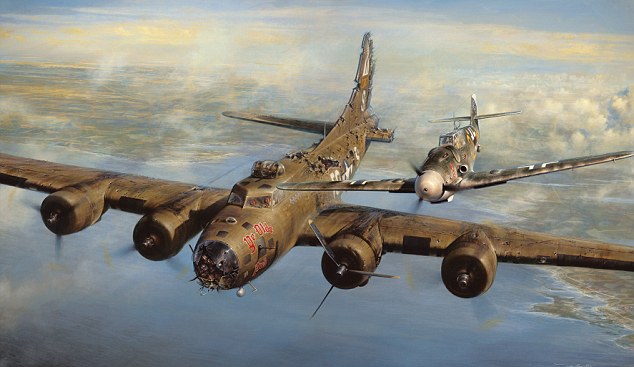- Luftwaffe pilot Lt Franz Stigler refused to shoot down near-destroyed Allied bomber
- Instead he guided stricken pilot Lt Charlie Brown to safety
- A phone call led to a tearful reunion of the two World War II veterans
Tony Rennell
Daily Mail
July 22, 2013

The lone Allied bomber was a sitting duck. Holed all over by flak and bullets and down to a single good engine, it struggled simply to stay in the air over Germany, let alone make it the 300 miles back to England.
The rear gunner’s body hung lifeless in his shattered turret, another gunner was unconscious and bleeding heavily, the rest of the ten-man crew battered, wounded and in shock. The nose cone had been blown out and a 200mph gale hurtled through the fuselage.
Somehow the pilot, 20-year-old Lt Charlie Brown, still clung to the controls — and the last vestiges of hope.
He had already performed miracles. Returning from a daylight bombing run to Bremen, he had manoeuvred the plane magnificently through a pack of Messerschmitt fighters, taken hit after hit, then spiralled five miles down through the air, belching smoke and flames, in an apparent death dive before somehow levelling her out less than 2,000ft from the ground.
If common sense prevailed, he would order everyone to bail out and leave the B-17 Flying Fortress to its fate. He and the crew would parachute to safety, prisoners of war but alive. But that would mean leaving an unconscious man behind to die alone, and Brown refused to do that.
Mercifully, though, he realised as he coaxed the massive plane along at 135mph, barely above its stalling speed, the German fighters had disappeared. They must have seen the bomber — part of the U.S. Air Force based in eastern England — plummeting to earth that day in December, 1943, and ticked off another kill before returning to base.
There was a faint chance, then, they might make it home after all, even though, as his flight engineer now reported after an inspection of the plane’s blood-spattered interior, ‘we’re chewed to pieces, the hydraulics are bleeding, the left stabiliser is all but gone and there are holes in the fuselage big enough to climb through’.
In the distance, agonisingly close, Brown could see the German coastline, and ahead of that the North Sea and open skies back to England. Spirits rose — until a glance behind revealed a fast-moving speck, a lone Me109, getting bigger and bigger by the second, closing in.
